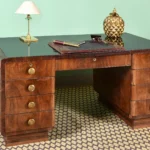
How to Clean Headrest on Recliner: Step-by-Step Tips and Info
This post may contain affiliate links or Google Ads and we may earn a small commission when you click on the links at no additional cost to you. As an Amazon Affiliate, we earn from qualifying purchases. This is at no additional cost to you and helps with our website expenses.
How to clean a headrest on a recliner is a question many people find themselves asking.
After all, these plush seating options are a popular spot for relaxation, making them a magnet for various types of dirt and stains.
In this comprehensive guide, we’re going to dive into all the essential steps you need to take to keep your recliner’s headrest – be it leather, suede, or fabric – clean and inviting.
Why Learning How to Clean Headrest on Recliner Matters
From lazy weekends to movie nights, our recliners get a lot of use. And let’s not forget the favorite seating spot designation – my husband, for instance, has claimed the leather recliner as his throne.
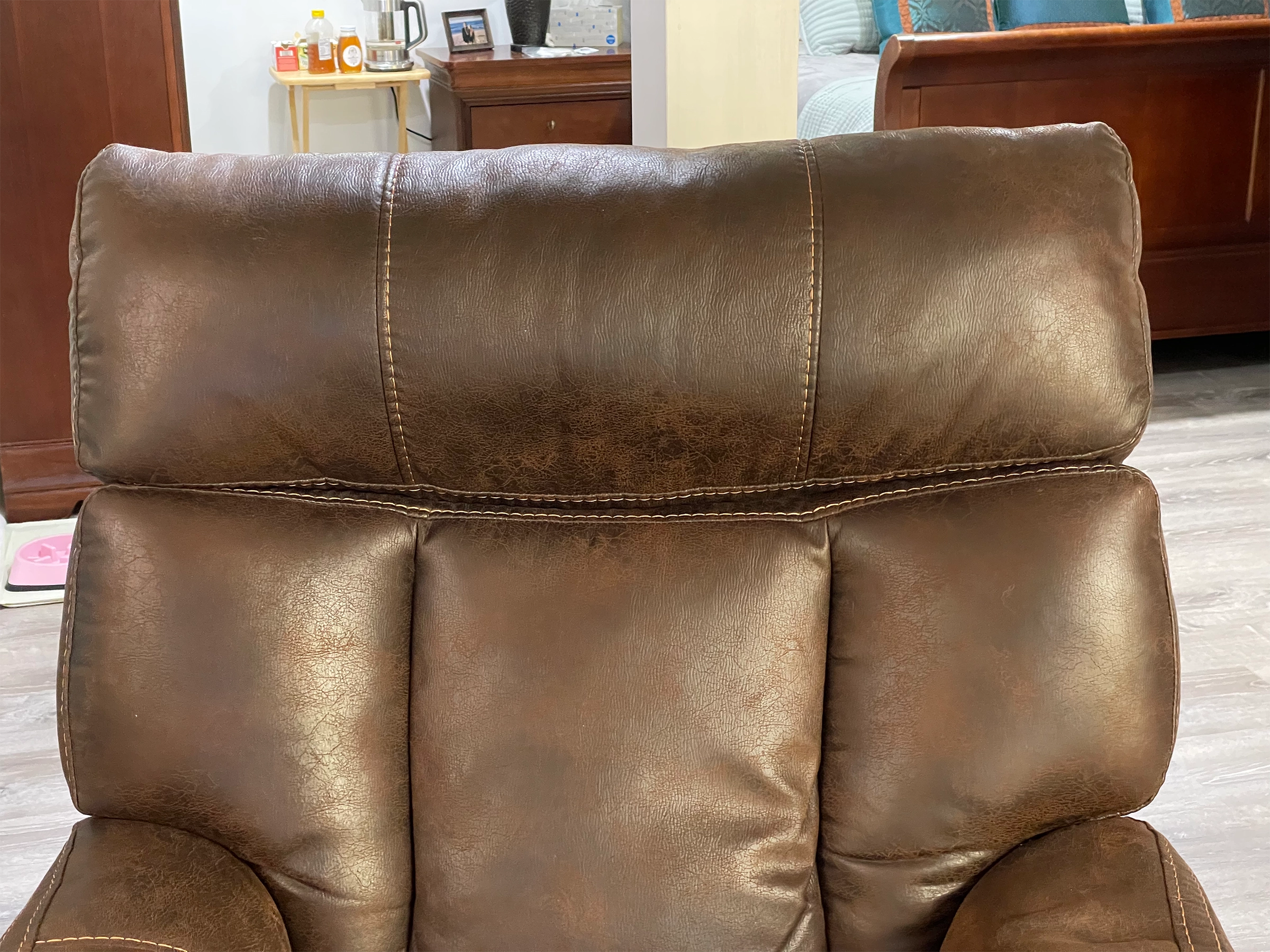
Unfortunately, this frequent use results in a buildup of oils from his hair, residue from food and drinks, and even traces of hair products, all landing predominantly on the headrest.
Cleaning your recliner headrest regularly is therefore not just about aesthetics, it’s a matter of hygiene and maintaining the longevity of your favorite lounging furniture.
BTW, don’t hesitate to add this chore to your husband’s honey do list

Understand Your Recliner Material
Before we begin, it’s essential to understand your recliner’s material. Different materials demand different cleaning methods. In the upcoming sections, we’ll outline how to handle common stains and everyday cleaning for leather, suede, and fabric headrests.
Types of Recliner Materials and Their Cleaning Needs
Knowing the type of material your recliner is made of is key to determining the best cleaning approach. Let’s delve into the specifics of cleaning leather, suede, and fabric recliners.
Leather Recliners
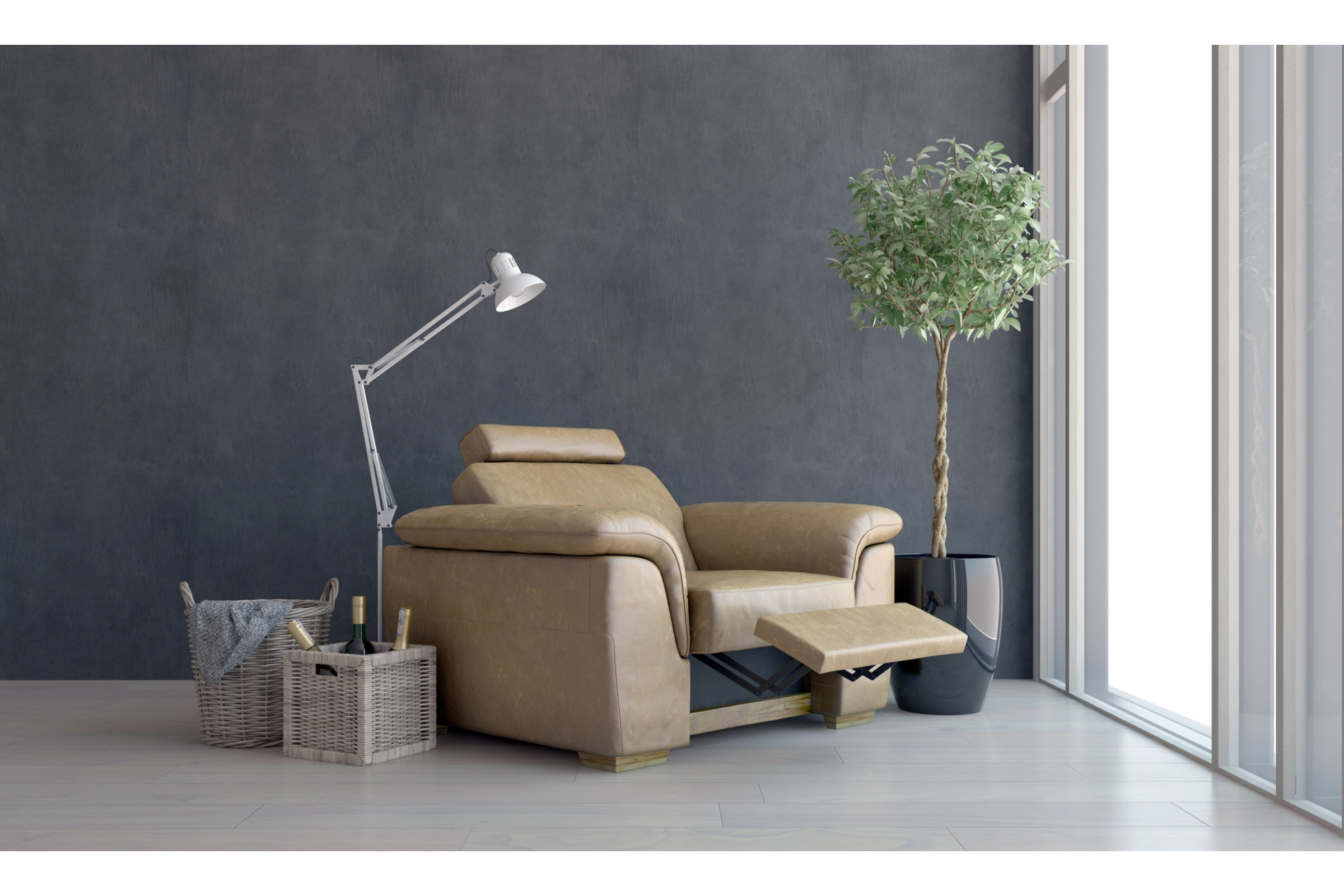
Leather recliners, like the one my husband swears by, are a popular choice for many due to their durability and classy appearance. However, they need a specific cleaning approach to maintain their sheen.
- Daily Cleaning: Wipe the headrest with a dry, clean cloth to remove dust and prevent it from settling in.
- Stain Removal: For stubborn stains, use a leather cleaning solution. Apply a small amount of the solution onto a cloth and gently dab the stain, taking care not to rub as it could spread the stain or discolor the leather.
- Conditioning: Regularly condition the leather to maintain its smooth texture and prevent cracking. You can find a variety of leather conditioners in stores or online.
Suede Recliners
Suede recliners offer a soft and warm feel that’s hard to resist. However, suede is more susceptible to damage and staining due to its porous nature.
- Daily Cleaning: Use a suede brush to remove dust and keep the headrest looking fresh. Brush gently in the direction of the fibers, not against them.
- Stain Removal: For wet stains, blot immediately with a clean cloth. For dry stains, use a special suede eraser or a white pencil eraser. Rub gently until the stain is gone.
- Protection: Consider using a suede protector spray to shield your headrest from stains and spills. This can be especially helpful in a household with kids or pets.
Fabric Recliners
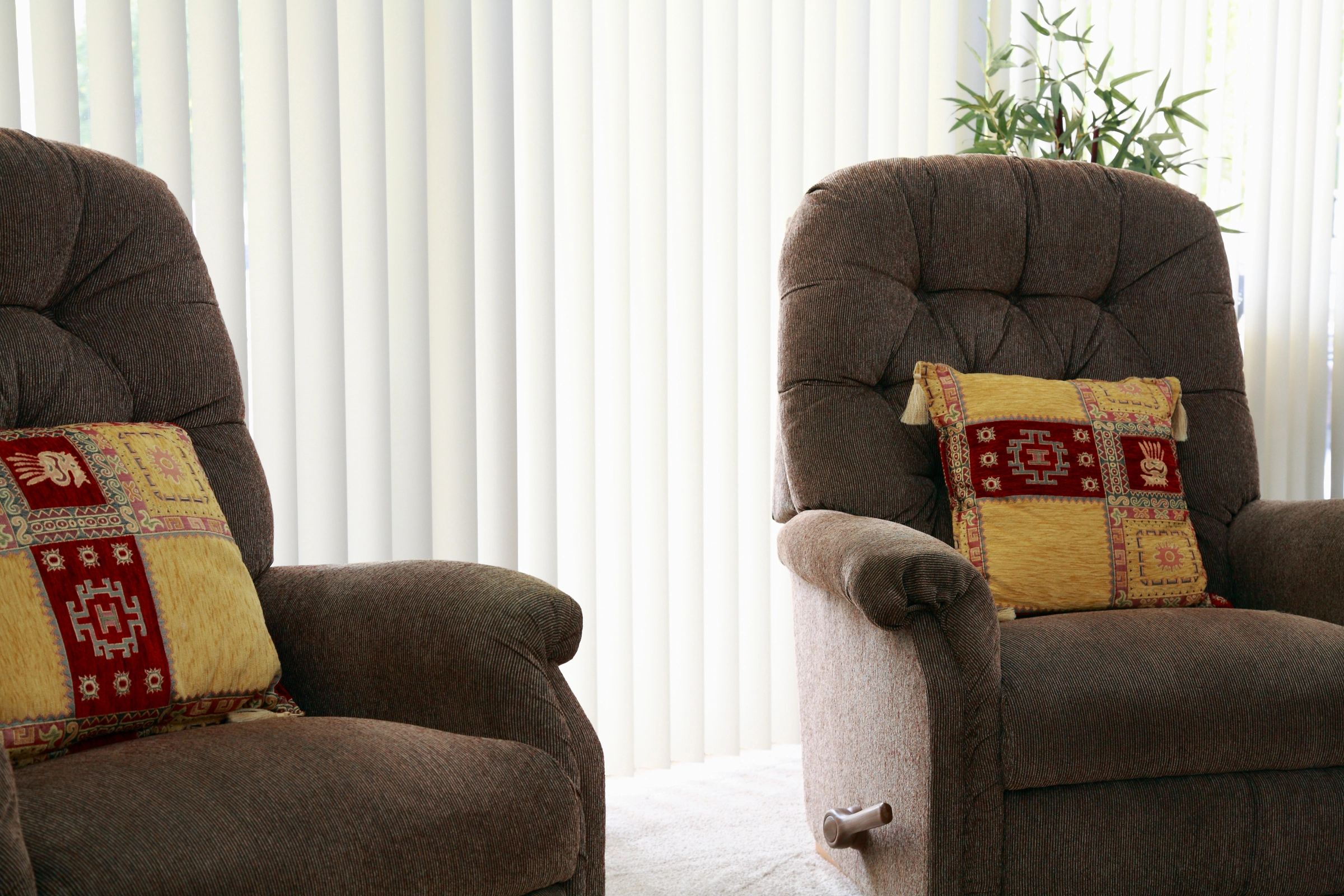
Fabric recliners are loved for their comfort and variety of design options. However, they can harbor dust and allergens more easily.
- Daily Cleaning: Regularly vacuum the headrest with a soft brush attachment to remove dust and allergens.
- Stain Removal: Use a fabric cleaner for stubborn stains. Apply the cleaner to a cloth first, then gently blot the stain. Always do a patch test in an inconspicuous area to ensure the cleaner doesn’t discolor the fabric.
- Deep Cleaning: Depending on use and exposure to dirt, schedule a deep clean once or twice a year using a fabric shampoo or a steam cleaner.
By knowing the right methods to clean your recliner headrest according to its material, you’ll be able to maintain its cleanliness and longevity.
Types of Stains and How to Clean Headrest on Recliner
Different stains call for different cleaning strategies. Below, we’ll break down how to clean the most common types of stains from your recliner headrest, whether they’re caused by oil or grease, food and beverages, sweat, or hair products.
How to Clean Headrest on Recliner – Oil or Grease Stains
Oil and grease can make their way to your headrest in several ways – think hair products, skin oils, or accidental food spills. Here’s how to tackle these:
- Leather: Wipe the stain with a dry cloth to remove any excess oil. Then, sprinkle a bit of baking soda or cornstarch onto the stain and let it sit for a few hours. The powder will absorb the oil. Afterwards, wipe it away and clean the area with a leather cleaner.
- Suede: Blot the stain with a dry cloth. Next, apply a layer of cornstarch or talcum powder and let it sit overnight. Brush off the powder gently using a suede brush.
- Fabric: Use a cloth to blot out as much of the grease as possible. Apply a small amount of dish soap to the stain and gently rub it in using your fingers. After a few minutes, rinse the soap off with a damp cloth and let it dry.
How to Clean Headrest on Recliner – Food and Beverage Stains
Snack accidents happen, especially during those exciting movie nights. Here’s how to clean food and drink spills:
- Leather: Blot any wet spills immediately using a clean cloth. For dried stains, use a cloth dampened with a mild soap solution, then rinse with a damp cloth and dry it off.
- Suede: Use a suede eraser or a white pencil eraser to rub off any dried food stains. For wet stains, blot immediately with a clean cloth and allow it to dry. Use a suede brush to restore the texture.
- Fabric: Blot wet stains immediately to prevent them from setting in. For dried stains, you can use a gentle fabric cleaner. Always remember to do a spot test first.
How to Clean Headrest on Recliner – Sweat Marks
Frequent use of your recliner, especially during warmer months, can lead to sweat stains. Here’s how to handle them:
- Leather: Wipe with a dry cloth regularly to prevent buildup. For visible stains, use a leather cleaner.
- Suede: Due to its porous nature, sweat stains on suede should be professionally cleaned to prevent damage.
- Fabric: Use a cloth dampened with a mild soap solution to clean the area, then rinse with a damp cloth and let it dry.
How to Clean Headrest on Recliner – Hair Product Residue
Styling products can leave a residue on your headrest over time. Here’s how to get rid of it:
- Leather: Use a leather cleaner to remove any buildup of hair products.
- Suede: Regularly brush the headrest with a suede brush. For heavy residue, consider professional cleaning.
- Fabric: Use a fabric cleaner, following the same process as for food and beverage stains.
How to Clean Headrest on Recliner – Everyday Cleaning Methods
In addition to addressing specific stains, regular cleaning can go a long way towards maintaining your recliner headrest’s cleanliness and longevity. Let’s discuss some everyday cleaning strategies for each type of material.
Daily Care for Leather Headrests
- Wipe it Down: Use a dry, clean cloth to wipe down the leather headrest daily. This simple routine can help remove dust and prevent it from settling in.
- Condition Regularly: Leather needs hydration to keep it supple and prevent it from drying out and cracking. Using a leather conditioner every couple of months can help maintain its luster.
Suede Headrests Daily Care
- Brush it Off: Suede is delicate and can lose its texture over time. Using a suede brush, gently brush your headrest daily in the direction of the fibers, not against them, to maintain its appearance.
- Protect the Material: Given its susceptibility to stains, it’s worth considering using a suede protector spray to add an extra layer of defense against spills and stains.
Daily Care for Fabric Headrests
- Vacuum Frequently: Fabric can easily trap dust and allergens. To keep it fresh, vacuum the headrest weekly using the upholstery attachment on your vacuum cleaner.
- Spot Clean: If you notice a small stain, act fast! Use a mild fabric cleaner to spot clean. Make sure to do a patch test in an inconspicuous area first.
These simple habits can make a significant difference in keeping your recliner headrest clean and ready for relaxation at any time.
How to Clean Headrest on Recliner – Deep Cleaning Methods
While everyday cleaning is essential, every now and then, your recliner headrest may need a deep clean. Here are some suggestions based on the type of material.
Deep Cleaning a Leather Headrest
Leather headrests need careful attention during deep cleaning to prevent damage.
- Vacuum: Start by vacuuming the surface using an upholstery attachment to remove any loose dust and dirt.
- Leather Cleaner: Apply a quality leather cleaner on a soft cloth and gently clean the surface. Don’t forget to test the product on an inconspicuous area first to ensure it doesn’t discolor the leather.
- Condition: Once the headrest is clean and dry, apply a leather conditioner to keep the material hydrated and prevent it from cracking over time.
Deep Cleaning a Suede Headrest
Given its delicate nature, consider seeking professional cleaning services for a suede headrest. If you choose to do it yourself, follow these steps:
- Brush: Use a suede brush to remove any loose dust and dirt.
- Suede Cleaner: Apply a good quality suede cleaner on the headrest as per the product’s instructions. Be sure to test on a small hidden area first.
- Dry and Brush: Allow the headrest to dry naturally, away from direct heat or sunlight, and gently brush it to restore its texture.
Deep Cleaning a Fabric Headrest
Fabric headrests can usually handle more rigorous cleaning methods.
- Vacuum: Use an upholstery attachment to vacuum the headrest, removing any loose dust and dirt.
- Fabric Cleaner or Shampoo: Apply a suitable fabric cleaner or shampoo on the headrest and gently clean as per the product’s instructions. Always perform a spot test first.
- Dry: Allow the headrest to dry naturally. Avoid using heat to speed up the drying process as it might shrink the fabric.
A well-executed deep cleaning process can freshen up your recliner headrest, making your favorite seat even more inviting. However, prevention is always better than cure.
Preventive Measures to Protect Your Recliner Headrest
Just as with our health, preventive care is the best strategy when it comes to maintaining your recliner headrest. Let’s explore some methods to prevent stains and prolong the life of your recliner, regardless of its material.
Use Covers or Throws
One of the most effective ways to protect your recliner headrest is by using covers or throws. These add an extra layer of defense against dirt, oils, and spills.
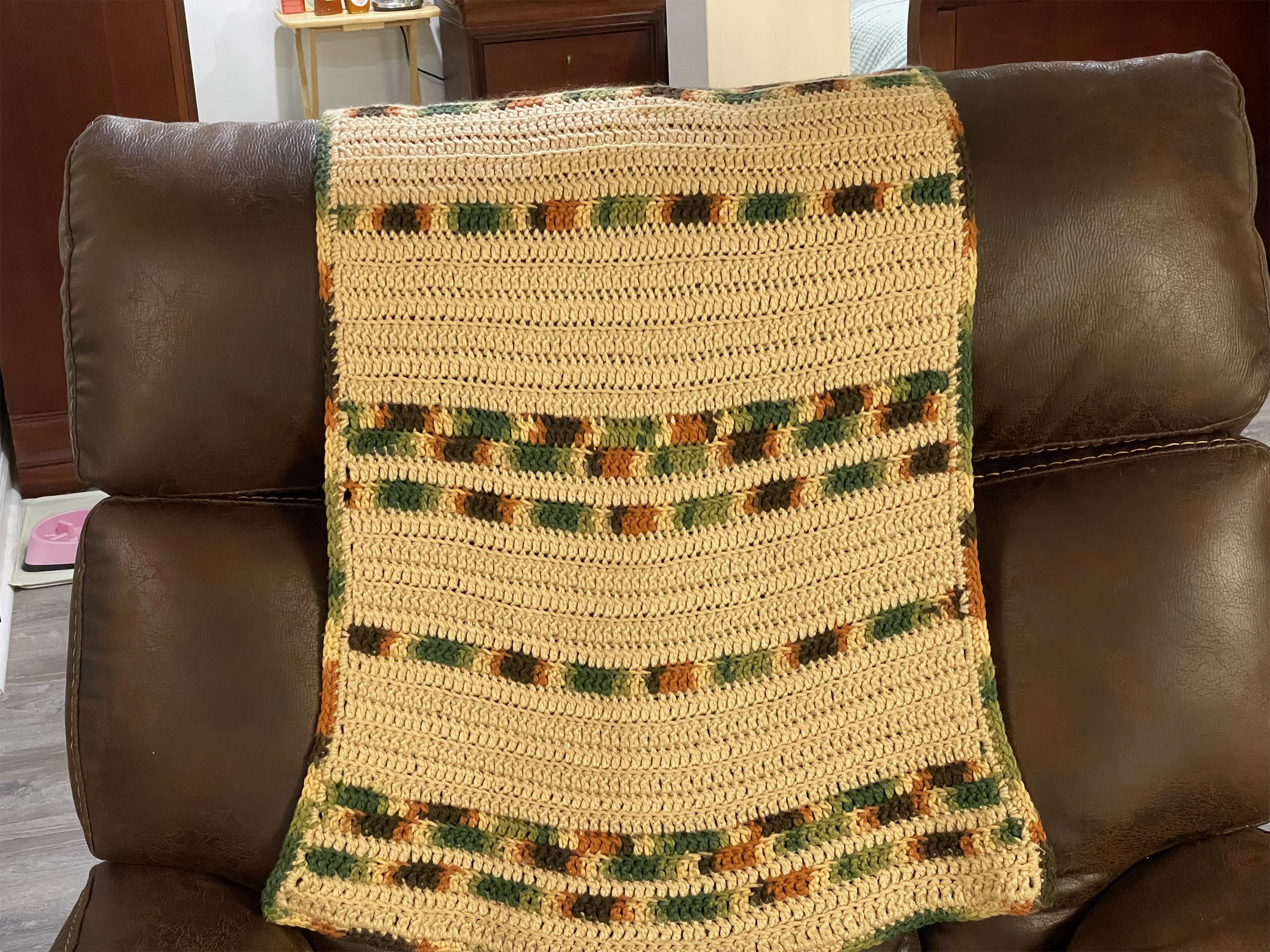
For instance, we use a prayer shawl on the back of my husband’s leather recliner. Not only does it help keep the headrest clean, but it adds a personal touch to the furniture as well.
Avoid Direct Sunlight
Direct sunlight can cause the material of your recliner to fade and deteriorate over time. Whether it’s leather, suede, or fabric, try to position your recliner in a spot where it won’t be constantly exposed to sunlight.
Regular Maintenance
Maintaining a regular cleaning schedule will go a long way in preserving your recliner. This includes both daily cleaning practices, like dusting or vacuuming, and periodical deep cleaning.
Handle with Clean Hands
It might seem obvious, but ensuring your hands are clean before using your recliner can help prevent a build-up of oils and dirt. This is especially important if you’ve been cooking, gardening, or doing other work that can dirty your hands.
Promptly Tackle Spills and Stains
Accidents happen. When they do, make sure to act fast! The quicker you clean up a spill, the less likely it is to become a stubborn stain.
Prevention is indeed better than cure, and these measures can help keep your recliner headrest in top-notch condition.
Cleaning Solutions: Natural, Homemade, and Commercial
Having the right cleaning solution for your recliner’s headrest is key to keeping it clean and prolonging its lifespan. Whether you prefer natural, homemade, or commercial solutions, there’s something out there for everyone.
Natural Solutions
Natural cleaning solutions are great for those who want to avoid harsh chemicals.
- Vinegar and Water: A mixture of equal parts white vinegar and water can work wonders on fabric recliners. However, it’s not suitable for leather or suede, as it can cause discoloration or damage.
- Baking Soda: This household staple is great at absorbing grease and oil stains. It can be used on all types of material, but should be brushed off completely after use.
Homemade Solutions
Creating your own cleaning solution can be a cost-effective and eco-friendly option.
- Mild Soap Solution: A few drops of mild dish soap in a cup of water can create a gentle cleaning solution suitable for most types of recliner materials.
- DIY Fabric Freshener: Mix one part fabric softener with four parts water in a spray bottle for a quick and easy fabric freshener. This should be avoided on leather and suede recliners.
Commercial Cleaning Products
Commercial cleaners offer a convenient and often more powerful solution. It’s essential to choose a product designed for the specific material of your recliner.
- Leather Cleaners and Conditioners: These are formulated to safely clean leather without causing damage or discoloration. They also help to maintain the leather’s texture and appearance.
- Suede Cleaners: These are designed to remove stains and dirt from suede without damaging the delicate material.
- Fabric Cleaners: Available in various formulas, these are designed to clean fabric recliners effectively. Choose one that’s suitable for the specific type of fabric your recliner is made of.
Remember, no matter what type of cleaning solution you choose, always test it on an inconspicuous area first to ensure it doesn’t discolor or damage the material.
Final Thoughts on How to Clean Headrest on Recliner
Understanding how to clean the headrest on a recliner is crucial in maintaining your furniture’s cleanliness and durability.
Whether it’s leather, suede, or fabric, each material has specific needs and requires different cleaning methods.
From tackling various stains like oil, food, and hair products, to regular cleaning and deep cleaning procedures, there’s a lot to consider.
However, cleaning doesn’t have to be a chore. With the right preventative measures, such as using a cover or ensuring prompt cleanup of spills, you can significantly reduce the amount of cleaning needed.
Plus, there are plenty of cleaning solutions available, whether you prefer natural, homemade, or commercial products.
So sit back, relax, and enjoy your clean, comfortable recliner!











